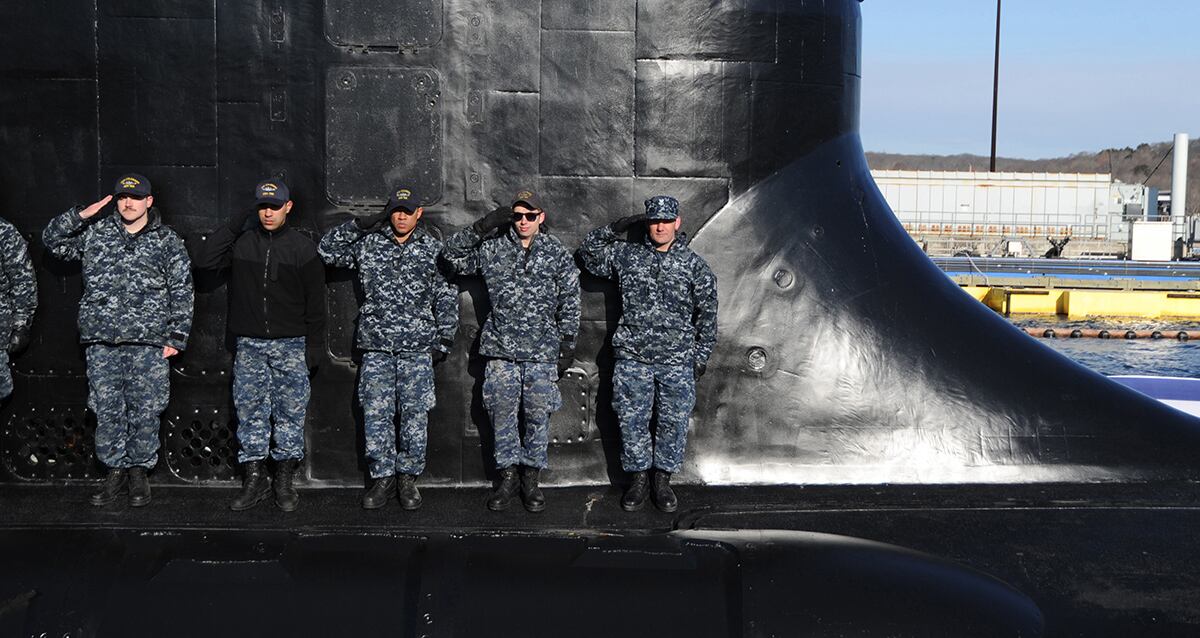GROTON, Conn. — The U.S. Navy is working to build three attack submarines in some years as opposed to two, and wants to keep five of its attack submarines in service longer than expected to address a dip in the number of nuclear-powered attack submarines in coming years.
The U.S. attack submarine fleet is expected to shrink by 20 percent over the next decade. There are 52 attack submarines today; by 2028, that number is expected to dip to 42. The Navy has said it needs a fleet of 66 attack submarines, but that isn’t expected to happen until 2048 under current plans.
Meanwhile, the Navy continues to drive down the construction timeline for the Virginia-class attack submarine program. At the outset, the boats were built in 84 months. Then the Navy reduced the construction timeline to 74 months, and now the goal is to build them in 66 months.
RELATED

The Navy wants to knock off even more time, which means pressure is mounting on Electric Boat and hundreds of submarine suppliers in Connecticut to keep on schedule. Already, EB has been busy building two Virginia-class submarines a year with Newport News Shipbuilding and thousands of suppliers across the country. The submarines cost about $2.7 billion each to build.
“Everybody has, I think, reached consensus that this part of the fleet is more and more prized by combatant commanders, and now that the dip in fleet size is getting imminent, time and delivery is even more of a priority,” said U.S. Rep. Joe Courtney, D-2nd District.
The Navy is negotiating the contract for the next group of attack submarines it wants to build from 2019 to 2023. Congress authorized the production of up to 13 Virginia submarines during that period, but the Navy has indicated it wants to build 12. That would mean building three submarines in 2022 and 2023, respectively. Costs still are being figured out, and Congress would have to approve any funding.
“I’m still committed to having options in that contract for additional submarines in ’22 and ’23, should that be something we jointly decide to do and can afford,” Assistant Secretary of the Navy James Geurts said at a recent congressional hearing.
The Navy also is proposing to extend for up to 10 years the service life of five Los Angeles-class attack submarines, which the Virginia submarines are replacing. At this point, no Groton-based submarines are being considered for service life extension.
The Virginia program has been hailed for boats being delivered on time and within budget, but there have been setbacks. Some boats were affected by welding issues, causing delays in their getting out into the fleet, and in some cases there’s been delays in getting parts, which has slowed down construction.
The 15 Virginia submarines currently in the fleet were delivered within 5 percent of the contracted deadline, according to Capt. Chris Hanson, the Navy’s new Virginia program manager.
“To do this work, we have to ensure the vendor base, our 5,000 vendors, is feeding the system with quality parts on time,” Hanson said.
Keith Macdowall, vice president of Prime Technology LLC in North Branford, which makes display systems for submarines similar to those seen on car dashboards, said EB has been proactive about alerting its suppliers what to expect with the ramp-up in submarine production.
“The nuclear shipbuilding supply base is poised to ramp up production capacity to support the increased demand associated with the Navy’s Shipbuilding Plan,” Liz Power, spokeswoman for EB, said in an emailed statement. “We have developed strategic plans to ensure we have the workforce, facilities and supply chain in place to respond to current and potential needs, and have shared these plans with the Navy.”
The biggest concern for suppliers is getting materials on time and ensuring they have the equipment and employees in place to do the work, according to Macdowall. Federal lawmakers have appropriated tens of millions of dollars to help suppliers prepare for the ramp-up, such as buying parts in advance.
Macdowall, who is co-chairman of the Submarine Industrial Base Council, said the organization had a record turnout for its annual summit in Washington in March. He estimated 400 people attended, which shows the level of interest in this work, he said.





